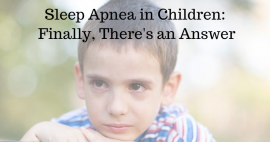
Sleep Apnea in Children: Finally, There’s an Answer
A child’s snoring should NEVER be ignored. It’s as big of a red flag as you’re going to get for obstructive sleep apnea in children, who unfortunately present the condition slightly differently than adults. While the condition normally impacts middle aged men (and goes underdiagnosed even then), it can slip dangerously under the radar for most other demographics. Statistically, 3% to 12% of all children snore, and around 1%-3% percent of all children have sleep apnea.
As dentists, you have front row access to a child’s mouth development, and it’s no hyperbole to say that you could change the course of a child’s life and gift a parent incredible peace of mind by providing a proper diagnosis. No parent wants something as potentially threatening to their child’s health and development as sleep apnea to go unnoticed.
Causes
While infected, enlarged tonsils and adenoids may be the most common cause of sleep apnea, allergies and certain developmental defects (e.g.- Low muscle tone in the mouth/upper airway, narrow air passages, underdeveloped maxillae) are all known causes.
Preventing Labels
Many of the cognitive difficulties caused by sleep apnea (poor attention span, trouble in school), combined with a child’s inability to articulate much of what they’re feeling, have the unfortunate effect leading to a hasty misdiagnosis of ADHD. Worse, the child may simply be dismissed as having a string of unexplained misbehaviors that are unimaginably frustrating for any parent and setting them up for horrible social and health complications later in life (high blood pressure, GERD, diabetes, etc). By simply observing a child’s airway, you can help prevent a child’s development from being impeded by unnecessary, possibly harmful medications and designations.
Treatment Options
While surgically removing enlarged tonsils/adenoids are the most common treatment, there are other options for managing OSA, depending on the cause and severity of the obstruction. Surgery to correct any preexisting malformations may be recommended depending on the case. Oral/dental appliances may also be recommended for older children whose facial bone growth is mostly complete. Continuous positive airway pressure (CPAP) is also an effective option if all else fails.
Symptoms
While some of the symptoms of sleep apnea in children may take on the same basic form as adults (cessation of breathing during sleep), they do present differently, especially taking into consideration that while adults tend to gain weight due to hormone fluctuations caused by a lack of sleep, many children with sleep apnea tend to demonstrate poor physical development and difficulty gaining weight.
Ask about your patients sleep history if they or their parents recognize the following symptoms. You may want to also inquire about your patient’s allergy history, and observe how their mouth is developing.
- Poor performance at school
- Breathing pauses during sleep
- Daytime sleepiness
- Difficulty with concentration
- Mouth breathing
- Poor attention span
- Behavioral issues
- Bedwetting
- Difficulty growing and gaining weight
Also consider that while the Apnea/Hypopnea Index (as indicated below) for adults with mild sleep apnea is 5-14, an AHI of 1 in a child is enough to indicate a positive diagnosis.
Apnea/hypopnea index for diagnosis in adults:
- Mild sleep apnea is classified as 5-14 episodes of interrupted breathing in an hour
- Moderate sleep apnea-15-30
- Severe sleep apnea-30 or higher
Below is the AHI index for children:
- Mild sleep apnea 1-5
- Moderate sleep apnea 5-15
- Severe sleep apnea-15 or higher
Sources:
- 2018, Pediatric Sleep Disordered Breathing/Obstructive Sleep Apnea, American Academy of Otolaryngology-Head and Neck Surgery, Retrieved 01/06/2017 from http://www.entnet.org/content/pediatric-sleep-disordered-breathingobstructive-sleep-apnea,
- Capdevila, O. S., Kheirandish-Gozal, L., Dayyat, E., & Gozal, D. (2008, February 15). Pediatric Obstructive Sleep Apnea. Retrieved January 30, 2018, from https://www.ncbi.nlm.nih.gov/pmc/articles/PMC2645258/
- Chang, S. J., & Chae, K. Y. (2010, October). Obstructive sleep apnea syndrome in children: Epidemiology, pathophysiology, diagnosis and sequelae. Retrieved February 03, 2018, from https://www.ncbi.nlm.nih.gov/pmc/articles/PMC3004499/
Be sure to get more info and news on sleep apnea on on our Facebook, Twitter, and LinkedIn!

